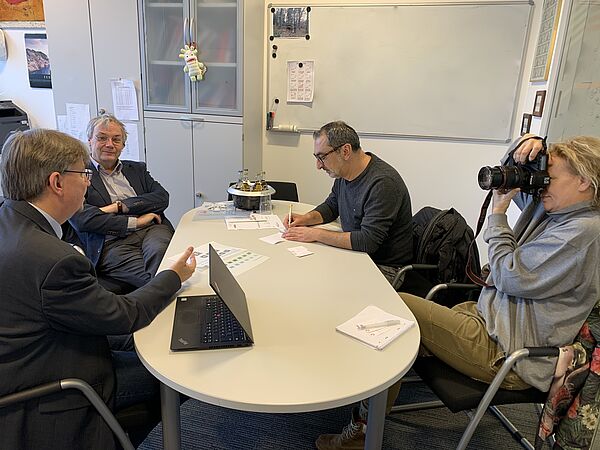Children need different medications than adults, women need different medications than men - the dose is different. Medications individually tailored to patients on edible paper coming out of a printer - that sounds incredible. The Institute for Industrial Information Technology (inIT), together with the Life Science Technologies department of the Ostwestfalen-Lippe University of Applied Sciences (TH OWL), has developed such a process that could revolutionize the way medicines are taken. In the form of a QR code on edible paper, all important treatment information is also provided at the same time.
Codes that help people get healthy - this is the vision being worked on by two scientists, Prof. Volker Lohweg, head of inIT, and Prof. Gerd Kutz from the Department of Life Science Technologies. They are printing liquid medicines on ordinary edible paper. Kutz: "The active ingredient is applied as a solution, which is similar to an inkjet printer, and the drug is then applied to the edible paper via the needle." The active ingredient itself is not visible, he said, so the solution is dyed with food coloring to make it easier to see and determine. It's also possible to print a QR code in different colors so the medicines can be distinguished, he said. "This is useful when patients need multiple medications," explains Prof. Lohweg. The darker the color, the stronger the dose. The active ingredient is injected into a cartridge and placed in a normal printer. Then, he says, only the amount the patient actually needs is printed. "Of course, this would be conceivable in pediatrics or psychiatry, where the doses are lower," says Prof. Kutz. One advantage is that, unlike taking drops, it is not so easy to miss something when using edible paper.
The special feature here, he says, is that the medication ends up on the paper as a special code, which makes it tamper-proof because it hides information for the doctor and patient that he has to decode a smartphone. "This makes it different from the usual barcodes, because it can store considerably more data. Among other things, we store encrypted patient data on the medicine there, as well as the date and frequency of taking the medicine," Prof. Lohweg said.
Eating paper that contains not only medicine but also a wealth of text - the combination makes their research unique so far, but also quite complex. "Since we have to read the barcode with camera systems, of course, we had to overcome major hurdles in data security," emphasizes Prof. Lohweg. But he says it was successful, and if such a edible paper medicine were to get lost, a stranger would not be able to do anything with it, because the encrypted data is secured without a clear name.
The two scientists, who have been working on the project for five years, emphasize that the process is not suitable for the mass production of drugs, but could only be used in pharmacies or in clinics that require special dosages of drugs. The researchers have already presented their idea of "medicines from the printer" to doctors as part of a cooperation with the Lippe Hospital. The doctors' reactions, they say, have been very positive. "We will continue our research and who knows, maybe some patients will soon be given barcodes to take - instead of drops," emphasize the two scientists, who firmly believe in the implementation of their idea.
Text: Erol Kamisli, Lippische Landes-Zeitung


